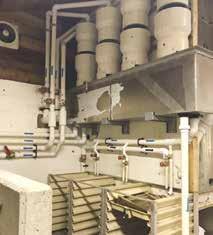
4 minute read
Boosting B.C.’s endangered salmon
new Facility helps B.c.’s endangered salmon population
The ‘Salmon Support Team’ during a brood capture safety talk.
in a year when many aspects of daily life have had to stop or be redirected, the Spruce City Wildlife Association (SCWA) managed to keep on flowing. After receiving a $240,000 grant from the B.C. Salmon Restoration Innovation Fund, the SWCA was able to spend 2020 upgrading their hatchery located on the Nechako River in prince George.
Salmon stocks in the mid- and upperFraser River have been identified as threatened and endangered, respectively. It has been over a decade since the area has seen a return of over 50 fish to the Endako or Chilako Rivers, whereas returns used to see over one thousand fish. The goal of the Association is to rebuild the salmon population while creating awareness.
The SCWA was established in 1970 to preserve and manage the area’s fish, wildlife, park, and outdoor recreational resources through conservation, education, and community outreach. The hatchery has been operating since 1986 and also houses the NechakoFraser Natural Resource Stewardship Centre. It is the only hatchery facility north of Kamloops on the Fraser watershed where the threatened stocks run.
“We wanted to create a more biosecure facility and take advantage of newer technologies that have been developed,” says Dustin Snyder, director of stock rebuilding programs at the SCWA. “At the same time, because of the landside situation at Big Bar, the Department of Fisheries and the Upper Fraser Fisheries Conservation Alliance came together in the interest of preserving and increasing the upper Fraser salmon stocks.”
Together, the Upper Fraser Fisheries Conservation Alliance (UFFCA) and the Department of Fisheries topped up the grant to allow the Association to fully achieve their renovation goals and, in turn, increase their capacity. This meant completely gutting the incubation area and jackhammering out the concrete floor to make way for new equipment, and a new separate structure has been constructed to hold industrial-grade chillers and pumps.
With the use of chillers, the hatchery tries to simulate the natural temperature of the river. The hatchery raises spring and summer Chinook which spawn at different times in different streams. Because these eggs are collected at varying times and areas, the temperatures must be adjusted for each stock. Maintaining the eggs at the hatchery is a delicate process, and with the new improvements, the SCWA is now able to mimic the temperatures required for each stock.
“The new controls which have been installed will allow us to be more precise in measuring both the temperature of the water and the amount of water in the pipes,” says


Snyder. “So it’s given us the ability to really hone in and get as close to nature as possible.”
Having a more exact measure on water flow means that the Association can double their incubation capacity because more stocks can be processed as more water is recirculated.
To increase water capacity, the main line from the aeration tower to all the troughs was removed and replaced with a larger pipe. Two of their three water wells underwent testing to confirm water capacity, and pumps and lines were replaced. In the event that one well breaks down, the other working well can continue to supply water.
“Our capacity has not only doubled because we have the two incubation systems,” says Snyder. “It’s almost fair to say that we’ve quadrupled capacity because we have a backup for every single component. Each incubation system has two pumps in case one pump fails, two chillers, two UV sterilizers, and two bio filters so that in the event that anything on a single incubation system goes down, we just have to flip a switch and that system can continue to run.”
An aeration system, which was added to the incubation system, was donated by a Department of Fisheries facility on the coast. New troughs that hold the hatched fry were designed and constructed by a local fabricator GAp Custom Manufacturing to ensure better flow and waste management, and a bio-secure holding area added to the outside of the facility will help control the spread of disease. “Adult fish sometimes have disease or bacteria on their skin,” says Snyder. “So to avoid disease transfer inside the facility, we now have a designated area outside where those adults can be kept.” This allows volunteers to take the eggs or milt from the adult fish and rerelease them without bringing them inside.
Due to the construction, the Association was only able to perform the brood capture this year — which yielded over 32,000 eggs — but they gave the eggs to the Department of Fisheries and the UFFCA. “We still achieved our goals and were able to contribute to the success of restocking salmon.” And since there won’t be any fish in the facility this year, the Association will use the time to complete construction and train new volunteers with the goal of starting their process in September. “We have a really dedicated crew,” says Snyder. “We call ourselves the Salmon Support team.”
The Salmon Support team, a core group of six volunteers, performed the brood capture this year without the help of additional volunteers. This allowed them to maintain their physical distance and follow all safety protocols. “This was our social circle for the entire summer and early fall,” says Snyder. “It wasn’t always ideal, but it worked.”
The SCWA hopes that it can again welcome the public to their new hatchery for their annual fry release in 2022. To learn more about the Spruce City Wildlife Association, visit them on Facebook or their website www.scwa.bc.ca. O











